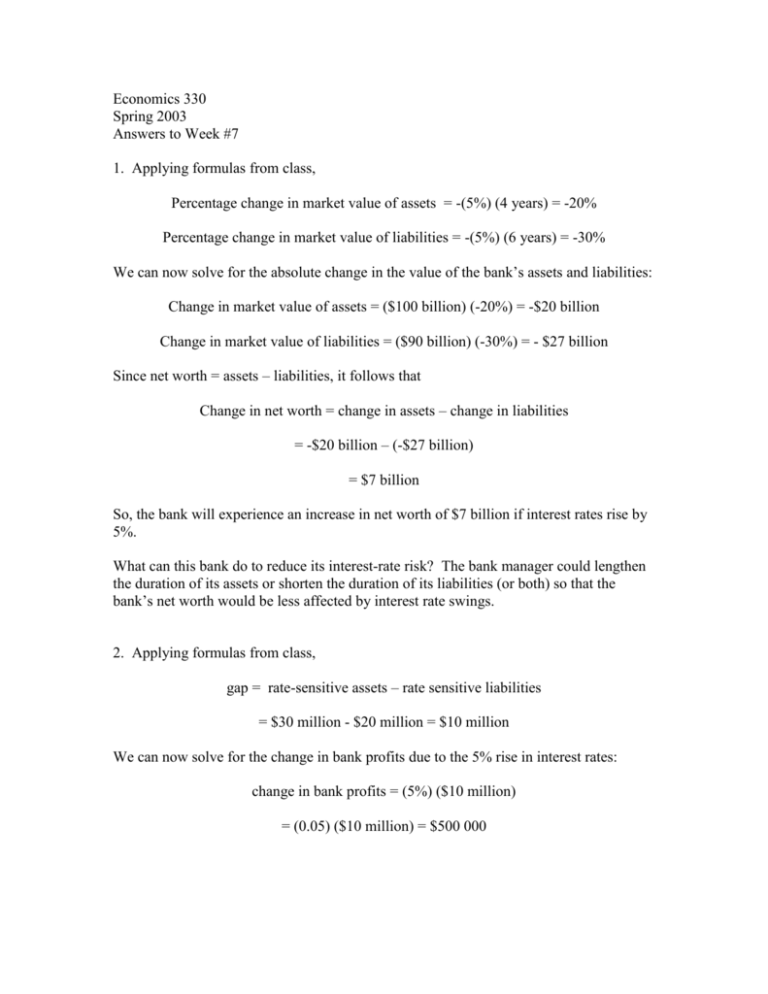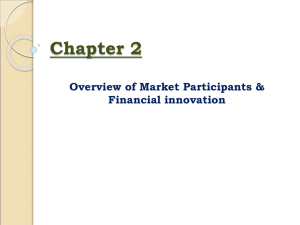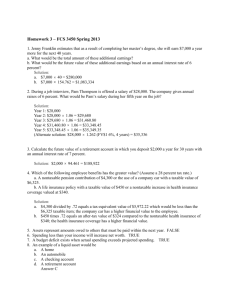Week 7 Solutions
advertisement

Economics 330 Spring 2003 Answers to Week #7 1. Applying formulas from class, Percentage change in market value of assets = -(5%) (4 years) = -20% Percentage change in market value of liabilities = -(5%) (6 years) = -30% We can now solve for the absolute change in the value of the bank’s assets and liabilities: Change in market value of assets = ($100 billion) (-20%) = -$20 billion Change in market value of liabilities = ($90 billion) (-30%) = - $27 billion Since net worth = assets – liabilities, it follows that Change in net worth = change in assets – change in liabilities = -$20 billion – (-$27 billion) = $7 billion So, the bank will experience an increase in net worth of $7 billion if interest rates rise by 5%. What can this bank do to reduce its interest-rate risk? The bank manager could lengthen the duration of its assets or shorten the duration of its liabilities (or both) so that the bank’s net worth would be less affected by interest rate swings. 2. Applying formulas from class, gap = rate-sensitive assets – rate sensitive liabilities = $30 million - $20 million = $10 million We can now solve for the change in bank profits due to the 5% rise in interest rates: change in bank profits = (5%) ($10 million) = (0.05) ($10 million) = $500 000 What can this bank do to reduce its interest-rate risk? It could attempt to “close the gap”; that is, it could try to hold more equal amounts of rate-sensitive assets and rate-sensitive liabilities. 3. Disintermediation is the removal of funds from a financial intermediary. Disintermediation is likely to occur when market interest rates (interest rates on marketable securities such as treasury bills) rise above the rates paid by financial intermediaries on their various deposits, perhaps due to legislated interest rate ceilings. What can reduce financial disintermediation? The removal of legislated deposit rate ceilings or the development of financial innovations that offer surplus spending units a return equal to or greater than returns available on other financial claims. Examples of financial innovations that arose in response to disintermediation are NOW accounts, money market deposit accounts (MMDAs), Eurodollars, and sweep accounts. If I take my funds out of my credit union and put them in a money market mutual fund, have I disintermediated? Credit unions can be classified as depository financial institutions. Money market mutual funds can be classified as investment financial intermediaries. Thus, I am just moving my funds from one financial intermediary to another, which is not disintermediaton (bypassing financial intermediaries altogether). One could argue that this movement of funds is disintermediation if we take Mishkin’s definition of disintermediation – the loss of deposits from the banking system – literally. Mishkin defines banks to be depository institutions (commercial banks, S&Ls, mutual savings banks, and credit unions). Since a money market mutual fund is not a bank, the movement of funds from a bank (credit union in this case) to the money market mutual fund is a loss of deposits from the banking system. I am more comfortable, however, with the first definition of disintermediation, since it makes more sense to be including both credit unions and money market mutual funds in the broad category of “financial intermediaries” and thinking about whether these “middlemen” are being bypassed by SSUs. 4. Advances in technology (computer and telecommunications technology): - - reduce transactions costs associated with managing, moving, and monitoring funds allow the globalization of financial markets because funds can be instantaneously around the world financial claims are particularly receptive to computer advances as these claims are quite fungible (easily transformed from one claim into another) - funds can be moved or relabeled easily, making innovation less costly technological advances have also allowed the risks associated with a particular financial asset to be unbundled or divided up into parts. These risks include credit risk, interest rate risk, exchange rate risk, and liquidity risk. - Unbundling allows the specific risks of one financial asset to be borne by different investors. In this way, the investors most able and willing to bear certain risks can do so, making financial markets more efficient. Changes in regulation: - - - to be more accurate, we should be thinking about the interaction between the prevailing economic environment and the structure of financial regulations; this interaction can increase the benefits of financial innovation financial institutions develop new products to avoid the binding effects of the regulations and increase profits when the economic environment changes so that regulatory constraints become burdensome this is the process of “loophole mining” - two regulations that have been major forces behind financial innovation: 1) reserve requirements 2) restrictions on deposit interest rates Increased competition: - increased global and domestic competition from other financial intermediaries increases the benefits of innovation to meet and beat the competition since the mid 1970s, financial institutions have been challenged by a sharp rise in competition from other domestic and global financial and nonfinancial institutions a more competitive environment => decreased profit margins => cost-saving technologies become more important greater competition => greater drive to innovate from both the cost and benefit perspectives Increased price volatility: - increased volatility causes the development of innovations to hedge the risk of losses from increased uncertainty the greater the volatility of price indexes, stock values, interest rates, exchange rates, etc., increases the risks and hence the costs associated with intermediation increased risks make financial innovation to deal with this volatility more beneficial new assets have been and are being developed to mitigate the risks associated with the volatility e.g. financial derivatives.









